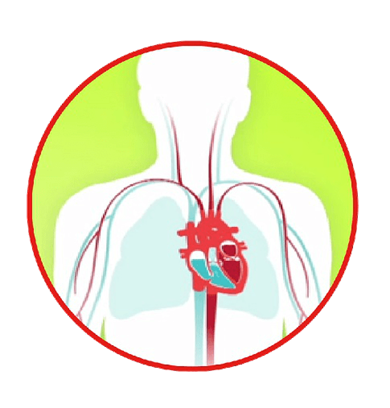What is Heart Failure?
Quick Facts
- Heart failure is when the heart is not pumping as well as it should.
- With heart failure, the body may not get the oxygen it needs.
- There is no cure for heart failure. But it can be managed with medications and healthy lifestyle choices.

Heart Failure
Heart failure describes a heart that cannot keep up with its workload. As a result, the body may not get the oxygen it needs.The term heart failure sounds like the heart is no longer working at all. Actually, heart failure, also called HF, means that the heart isn’t pumping as well as it should.
Your body depends on the heart’s pumping action to deliver oxygen- and nutrient-rich blood to the body’s cells. With heart failure, the weakened heart can’t supply the cells with enough blood. This results in fatigue and shortness of breath. Some people have excessive coughing. Everyday activities such as walking, climbing stairs or carrying groceries can become very difficult.
Heart failure is a serious condition, and usually there’s no cure. But many people with heart failure lead a full, enjoyable life when it is managed with heart failure medications and a healthy lifestyle. It’s also helpful to have the support of family and friends who understand your condition.
How the normal heart works
The heart is a strong, muscular pump a little larger than a fist. Its job is to pump the right amount of blood to all body parts. This is called circulation.
Watch an animation of blood flow through the heart.
The heart has four chambers:
- Two upper chambers called atria (when talking about just one, it’s an atrium)
- Two lower chambers called ventricles
The right atrium takes in oxygen-depleted blood from the rest of the body and sends it through the right ventricle to the lungs, which infuse the blood with oxygen.
Oxygen-rich blood travels from the lungs to the left atrium, then on to the left ventricle, which pumps it to the rest of the body.
The heart pumps blood to the lungs and to all of the body’s tissues. For the heart to work properly, the four chambers must beat in an organized way. A healthy heart has more than enough pumping ability to circulate blood properly.
What is heart failure?
Heart failure is a condition in which the heart muscle can’t pump enough blood to meet the body’s needs for blood and oxygen. Basically, the heart can’t keep up with its workload. HF is a lifelong condition, but you may have HF remission with treatment and healthy lifestyle changes.
Watch an animation of heart failure.
At first, the heart tries to make up for this by:
- Enlarging. The heart stretches to contract more strongly to keep up with the body’s demand to pump more blood. Over time, this causes the heart to get bigger.
- Developing more muscle mass. The increase in muscle mass occurs because the contracting cells of the heart get bigger. This lets the heart pump more strongly, at least initially.
- Pumping faster. This helps increase the heart’s output.
The body also tries to compensate in other ways:
- The blood vessels narrow to keep blood pressure up, trying to make up for the heart’s loss of power.
- The kidneys retain more salt and water instead of removing it through urine. This creates increased blood volume, which helps maintain blood pressure and allows the heart to pump stronger. But over time, this extra volume can overwork the heart, making heart failure worse.
These short-term measures mask heart failure, but they don’t solve it. Heart failure continues and worsens until these compensating processes no longer work.
Eventually, the heart and body simply can’t keep up, and the person has fatigue, breathing problems or other symptoms that usually prompt a trip to a health care professional.
The body’s ways of compensating help to explain why some people might not become aware of their condition until years after their heart begins its decline. (That is a good reason to have regular checkups with your health care professional.)
Heart failure can involve the heart’s left side, right side or both sides. However, it usually affects the left side first. Read more about the types of heart failure.






